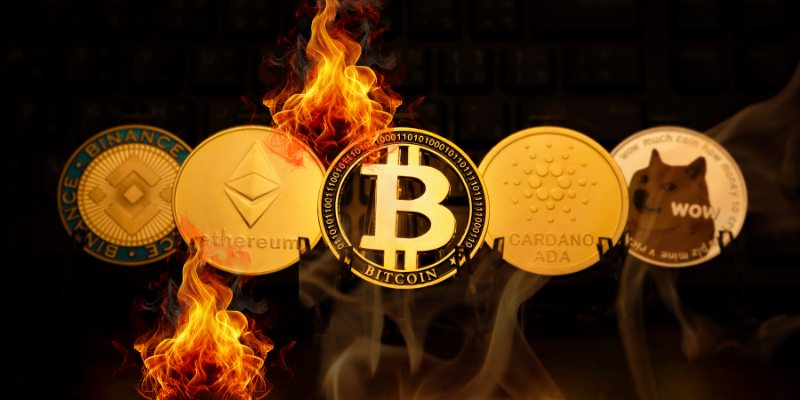What Does Burning Crypto Mean? Burning cryptocurrency, often referred to as a “token burn” or “coin burn,” is the process of permanently removing a certain number of tokens or coins from circulation by sending them to an inaccessible or unusable address, effectively reducing the total supply of the cryptocurrency.
What Does Burning Crypto Mean?
To “burn” crypto means to intentionally and permanently destroy a portion of a cryptocurrency’s tokens or coins by rendering them unusable. This is typically achieved by sending the tokens to a designated “burn address” or “black hole address”—a wallet address that no one can access because it has no associated private key or the private key is verifiably destroyed. Once tokens are sent to such an address, they are effectively removed from circulation and cannot be spent, traded, or recovered.
The term “burn” is metaphorical, as no physical destruction occurs. Instead, the process reduces the total supply of the cryptocurrency on the blockchain, which is transparent and verifiable due to the immutable nature of blockchain ledgers. For example, if a project burns 1 million tokens out of a total supply of 10 million, the circulating supply drops to 9 million, potentially impacting the token’s value and ecosystem dynamics.

How Does Crypto Burning Work?
The process of burning crypto varies depending on the blockchain and token standard, but the general steps are as follows:
Selection of Tokens to Burn: The entity initiating the burn (e.g., a project team, decentralized autonomous organization, or network protocol) decides how many tokens to burn. This could be a fixed amount, a percentage of the supply, or tokens collected from transaction fees.
Transfer to a Burn Address: The tokens are sent to a predefined burn address. Common characteristics of a burn address include:
No associated private key, ensuring the tokens cannot be accessed.
Publicly verifiable on the blockchain, allowing anyone to confirm the tokens are locked away.
Often labeled with addresses like 0x000…000 (a null address) or other identifiers specific to the blockchain.
Verification on the Blockchain: Once the transaction is confirmed, the tokens are recorded as sent to the burn address. Blockchain explorers (e.g., Etherscan for Ethereum, Solscan for Solana) allow users to verify the burn by checking the transaction and the address’s balance.
Reduction in Supply: The burned tokens are subtracted from the circulating supply. Some projects update their total supply metrics, while others maintain a distinction between total supply (including burned tokens) and circulating supply.
Smart Contract Burns (Optional): For tokens on smart contract platforms like Ethereum or Solana, burning can be programmed into the protocol. For example, a smart contract may automatically burn a percentage of tokens from each transaction or periodically burn tokens based on predefined rules.
Types of Crypto Burning
Burning mechanisms vary across projects and blockchains. Common types include:
Manual Burns:
The project team manually sends tokens to a burn address, often announced in advance to build anticipation.
Example: Binance’s quarterly BNB burns are manual, based on exchange profits.
Protocol-Level Burns:
Built into the blockchain’s code, these burns occur automatically as part of network operations.
Example: Ethereum’s EIP-1559 burns base fees from transactions, with over 4 million ETH burned by April 2025.
Transaction Fee Burns:
A percentage of transaction fees is burned, reducing supply with each network interaction.
Example: Solana burns a portion of transaction fees to maintain network efficiency.
Buyback-and-Burn:
Projects use profits or reserves to buy tokens from the market and burn them, reducing supply while supporting price stability.
Example: Binance uses 20% of its profits for BNB buyback-and-burn events.
Event-Based Burns:
Tokens are burned in response to specific milestones, such as community events or project upgrades.
Example: Shiba Inu burns SHIB during community-driven “burn parties” to engage its user base.

Why Do Projects Burn Crypto?
Crypto burning is employed for several strategic and economic reasons, depending on the goals of the project or network. The primary purposes include:
Reducing Supply to Increase Scarcity:
By decreasing the circulating supply, burning can create scarcity, potentially increasing the value of the remaining tokens if demand remains constant or grows (following basic supply-and-demand economics).
Example: Binance Coin (BNB) conducts quarterly burns, removing a portion of BNB from circulation based on trading volume on the Binance exchange, aiming to reduce the total supply to 100 million BNB.
Controlling Inflation:
Many cryptocurrencies have inflationary supply models where new tokens are minted over time (e.g., through mining or staking rewards). Burning tokens helps offset this inflation, stabilizing or increasing the token’s value.
Example: Ethereum introduced a burn mechanism in August 2021 via EIP-1559, where a portion of transaction fees (base fees) is burned, reducing ETH supply over time.
Incentivizing Network Participants:
Burning can align incentives by rewarding holders or discouraging speculative selling. For instance, projects may burn tokens to signal long-term commitment to value appreciation.
Example: Shiba Inu (SHIB) burns tokens to reduce its massive quadrillion-token supply, appealing to its community and encouraging holding.
Correcting Errors or Managing Supply:
Projects may burn tokens to correct mistakes, such as over-issuance during a token sale, or to adjust the supply after a strategic pivot.
Example: In 2022, Solana Labs faced a class action lawsuit alleging it failed to burn 8 million SOL tokens as promised after lending them to a market maker, highlighting the importance of transparency in burns.
Enhancing Token Utility:
Some protocols burn tokens to maintain economic balance within their ecosystems, such as funding development or reducing fees for users.
Example: Ripple (XRP) burns a small amount of XRP with each transaction to prevent spam attacks on the network, ensuring efficiency.
Boosting Investor Confidence:
Announcing a burn often signals a project’s commitment to long-term sustainability, boosting market sentiment and attracting investors.
Example: Terra (LUNA) burned tokens before its collapse in 2022 to stabilize its UST stablecoin, though this ultimately failed to prevent the crash.
Burning crypto is a strategic tool used by blockchain projects to reduce token supply, control inflation, and enhance value proposition. By sending tokens to inaccessible burn addresses, projects like Binance, Ethereum, and Solana aim to create scarcity, incentivize holders, and maintain ecosystem balance.
While burns can boost investor confidence and potentially increase token value, their success depends on transparency, execution, and broader market dynamics. For investors, understanding the purpose and impact of burns is essential to navigating the crypto market, as seen in cases like Solana’s controversial burn history. As the crypto space evolves, burning remains a key mechanism for shaping token economics and fostering sustainable growth.

